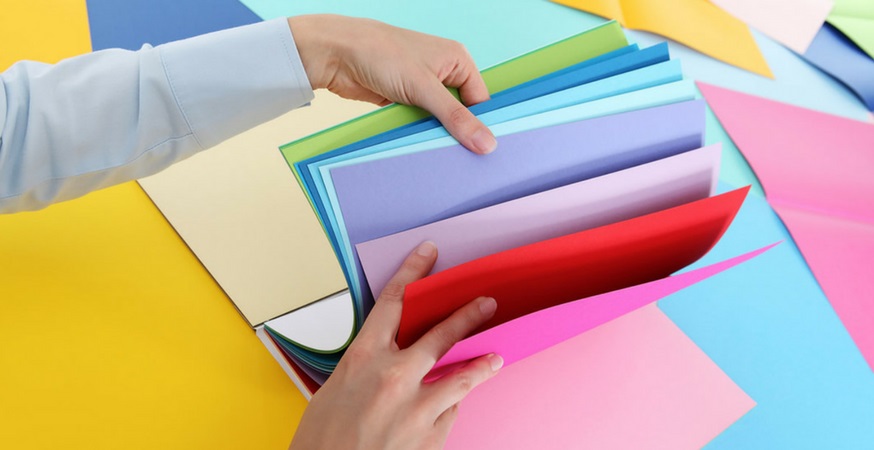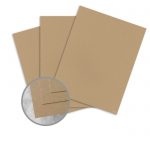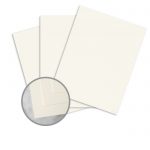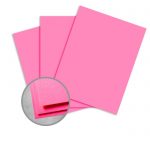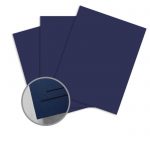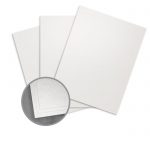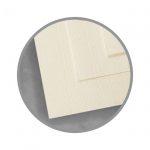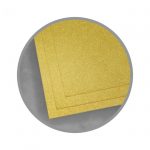So far in our Ultimate Guide to Card Stock, we’ve covered sheet size and paper weight, color and finish, and printing and finishing. In the final installment of our five-part series, we will dive into the different ways you can use card stock in graphic design, marketing, and paper crafting.
The variety of weights, sizes, colors and finishes that card stock is available in makes it suitable for a wide range of both professional and creative uses, including:
- Background and cover pages
- Booklets
- Business cards
- Embellishments
- Tags
- Borders & photo mats
- Mixed media
- Greeting cards & invitations
- Die-cutting
- Scrapbooking
- Artist trading cards
Whether you’re searching for report covers or crafting materials, there is a cardstock to suit your specific needs. But how do you know which card stock is the right one for your project?
When to Use Paper vs. Card Stock
Paper choice affects the way your work is received and shapes the opinion of your intended audience. This is an opportunity to present them with a tactile experience that conveys the quality, tone, and style of your work.
Here are some guidelines for selecting whether to use paper or card stock:
| Paper | Cardstock |
|---|---|
| Everyday and office use Documents Memos Schoolwork Flyers Letters | Business cards Greeting cards, note cards & invitations Announcements Prints Photos |
There are benefits to using both paper and card stock. A light sheet of paper is just as capable at conveying high quality as a heavy sheet of card stock, so be sure to consider your own personal preference while keeping in mind whose hands the work will end up in, as well as what is practical for your project and your budget.
If your project calls for card stock, Part 5 of the Ultimate Guide to Card Stock will help you narrow down your choices by highlighting some of the most important considerations for ensuring your work looks its best, including basis weight, sheet size, and paper finish.
Weighing in on Weight
Cardstock weight impacts both the look and feel of your project, as well as its durability. The weight you select is partly dependent on your intended end use – will your project only receive light use, or do you need something that can handle a little more wear and tear?
For most applications, there will be a range of cardstock weights for you to select from, allowing for some flexibility based on your personal preference.
Here is a brief overview of a few of our most popular weights and some of the ways they are commonly used:
| Weight | Uses |
|---|---|
| 65 lb Cover | Greeting cards, Postcards, Posters, Tickets, Crafts |
| 80 lb Cover | Business cards, Posters, Greeting cards, Invitations, Table tents, Folders, Tickets, Crafts |
| 100 lb Cover | Business cards, Flat cards, Invitations, Posters, Folders, Tickets, Crafts, Gift tags, Greeting cards |
| 105 lb Cover | Business cards, Awards, Certificates, Report covers, Menus, Crafts, Gift tags, Invitations |
When selecting the right card stock for your project, weight can also play a major role in the printing process, as well as what types of finishing services are available and how they will look. For instance:
- When it comes to embossing, if you choose a stock that’s too thick, it may not emboss properly. Aim for the sweet spot right around 80 lb cover.
- With regards to crafting or artwork, it’s important to remember that thin or transparent sheets can show glue and may pucker.
- Heavier sheets can crack during folding if they’re not scored properly, or tear during cutting and hole punching if dull tools are used.
- Thicker sheets may also require special consideration during the printing process, since these sheets don’t bend as easily.
If you’re printing at home, consult your printer’s owner’s manual to see what weights your machine can handle. If you’re working with a commercial printer, make sure to ask for their input on which weights are compatible with their equipment in order to achieve the look you want. You may also wish to explore professional finishing services, such as cutting and scoring, so your work isn’t damaged when you’re putting it together later.
For more on card stock weight, check out Part 2 of our guide.
Getting Serious About Sheet Size
The “right” sheet size depends on your project and your personal preferences. There are industry standards that you can adhere to, but don’t be afraid to work outside those guidelines – the only thing that limits you is your printer’s capabilities
At home, that usually means the sheet has to have one side that measures 8 ½ inches or smaller, although some home-use printers are capable of printing on larger sheets. If you’re taking your projects to a commercial printer, talk to them about size limitations before getting started. However, knowing common uses for the most popular sheet sizes should give you some idea of what will work for your project:
| Sheet Size | Uses |
|---|---|
| 8 1/2" x 11" | Standard print size for office and home use, day-to-day printing needs, documents, and flyers |
| 11" x 17" | Posters, architectural plans, notices, visuals |
| 12" x 12" | Standard scrapbook page size |
| 18" x 12" | Posters, artwork, display materials |
Learn more about sheet size and printer compatibility in our guide.
Having Fun with Finish
Since it can affect how card stock takes ink, paper finish plays a big role if you’re planning on using your card stock for printing. It’s important to keep this in mind while making your selection, and to know what type of finish will work best for your purposes:
| Finish | Uses |
|---|---|
| Gloss | The level of shine ensures that glossy card stock produces vibrant images, making it perfect for photography and colorful design projects. |
| Linen | With the luxurious texture of linen, this finish is popular for weddings, menus and craft materials. |
| Metallic | This finish has a pearly sheen that adds a touch of glamour, making it a popular choice for weddings, crafting, card making and more. |
| Smooth | Smooth to the touch, this sheet is ideal for text-heavy work and is commonly used for printing. |
Otherwise, paper finish can be a fun way to add dimension and interest to your work. You can use texture to play up certain elements or highlight themes in your art, crafts, cards, and scrapbook designs.
Find out more about finish in Part 3 of the Ultimate Guide to Card Stock.
Designing & Crafting with Card Stock
Card stock’s usefulness isn’t limited to one area – it has applications in a variety of different disciplines. Because of its versatile nature, card stock is utilized frequently by both crafters and print designers, among others. The wide selection of finishes, weights, sizes, colors, and finishing services available make card stock an easy tool for customizing, upgrading or embellishing a project.
Here are some of the most common design and crafting uses for card stock:
| Design | Crafting |
|---|---|
| Client projects Promotional materials Prints Booklets Handouts Invitations | Personal or artisanal use Scrapbooking Cardmaking Cut-outs Gift tags Decorations |
Countless Ways to Use Cardstock
The possibilities for how you can use cardstock are almost endless. Whether you’re looking to add some professional polish or simply get creative with crafts, cardstock can make an excellent addition to any work.
If you’re worried about how different physical characteristics of the cardstock will affect your end result, don’t forget to use our End Use filter to ensure you find a compatible sheet.
Shop our full range of card stock.
For help selecting the right card stock, contact us:
Phone: (800) 790-TPMS (8767)
Email: cs@thepapermillstore.com
Part 1: Introduction to Card Stock
Part 2: Paper Weights & Sheet Sizes
Part 3: Paper Finishes & Colors
Part 4: Printing & Finishing
Part 5: How and When to Use Card Stock

